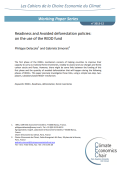One of the strong messages that came out of the United Nations Climate Change conference in Durban was that the private sector has to play an important role if we are to globally move toward a low carbon, climate resilient—or “climate compatible”—future. However, private investment will only flow at the scale and pace necessary if it is supported by clear, credible, and long-term policy frameworks that shift the risk-reward balance in favor of less carbon-intensive investment. The private sector also needs information on where to invest in clean energy in emerging markets, and it needs policy support to lower investment risk. Barriers to low carbon investments often include unclear and inconsistent energy policies, monopoly structures for existing producers, stronger incentives for conventional energy than clean energy, and a domestic financial sector not experienced in new technologies.
This brief examines the reasons behind the current drive towards sustainable public procurement (SPP), and the barriers that have to be overcome in order to implement it. It also looks at the key benefits and methods involved in SPP and green public procurement (GPP). The author explains that a significant share of the world’s GDP is associated with expenditures by governments. On average, total public expenditures by central and local governments are estimated to account for about 20% of GDP in OECD countries, and roughly 15% in non-OECD countries.
Governments have increasingly become involved in making their procurement “greener” or more sustainable. While green procurement and sustainable procurement refer to different concepts, the underlying idea is the same: to use public procurement in order to achieve desirable environmental and, in the case of sustainable public procurement, social outcomes.
Reasons for engaging in GPP or SPP include:
This report is very much focused on private sector led initiatives to responding to climate change. The report is based upon the results of a survey of business leaders committed to advancing climate action, especially in ways that build the resilience of vulnerable communities in developing countries. It offers help to companies with national, regional or global reach to develop strategies for dealing with the immediate to long‐term consequences of climate change in developing countries where they have operations, supply chains, employees, or customers.

The first phase of the REDD+ mechanism consists of helping countries to improve their capacity to carry out national forest inventories, notably to assess land-use changes and forest carbon stocks and fluxes. However, there might be some links between the funding of this first phase and the quantity of avoided deforestation that will happen during the following phases of REDD+. This paper precisely investigates those links, using a simple two-step, two-players, subsidiary-based REDD+ mechanism.
Bangladesh seeks to attain middle-income status by 2021, the 50th anniversary of its independence. To accelerate growth enough to do so, it will need to undergo a structural transformation that will change the geography of economic production and urbanization. Critical to its transformation will be the creation of a globally competitive urban space, defined here as a space that has the capacity to innovate, is well connected internally and to external markets, and is livable (Organization for Economic Cooperation and Development, or OECD 2006; World Bank 2010). This study identifies what is unique about Bangladeshs process of urbanization and examines the implications for economic growth. Through the lens of Bangladeshs most successful industry, the garment sector, it describes the drivers of and constraints to urban competitiveness. Based on the findings, it provides policy directions to strengthen the competitiveness of Bangladeshs urban space in ways that will allow Bangladesh to reach middle-income status by 2021.
